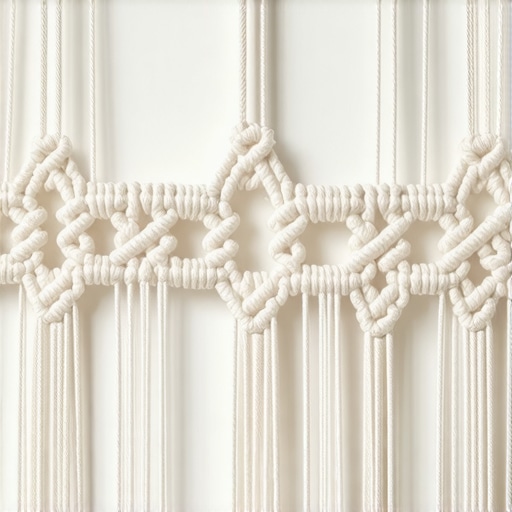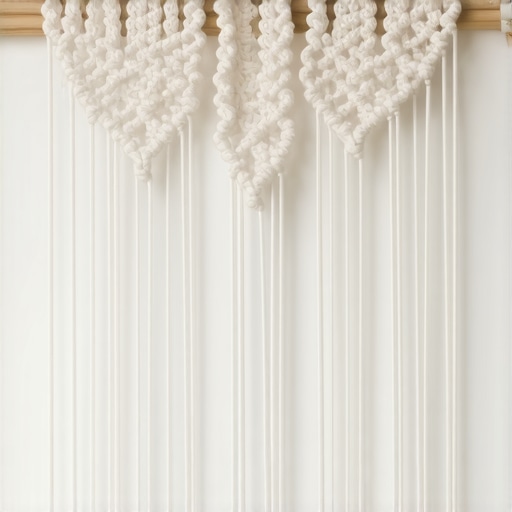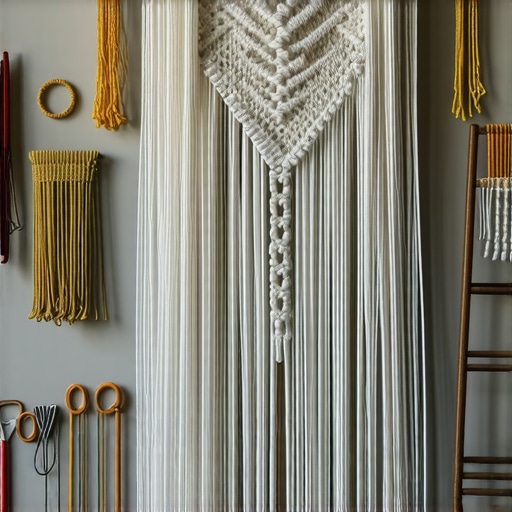My Journey into the World of Advanced Macramé
Ever since I picked up my first macramé knot years ago, I found myself captivated by the intricate patterns and the meditative process of knotting. Over time, I realized that basic knots could only take me so far, and I yearned to explore the more complex techniques that could elevate my wall hangings into true works of art. That’s when I delved into advanced macramé, focusing on large-scale wall hangings with complex knots that challenge both my skills and creativity.
Why I Fell in Love with Large-Scale Wall Hangings
There’s something incredibly satisfying about transforming a blank wall into a statement piece. When I started experimenting with larger projects, I discovered how the scale brought a new dimension to my work. I loved the challenge of managing long cords, maintaining tension, and ensuring the symmetry of intricate knot patterns. Plus, the tactile nature of complex knots added a new layer of depth and texture to my creations, making them truly unique pieces of home decor.
Essential Techniques for Complex Knots in Macramé
To master advanced macramé, I focused on learning a variety of complex knots, such as the Boyfriend Knot, Josephine Knot, and the Square Knot with multiple cords. These knots, when combined, form stunning patterns that can serve as the focal point of a large wall hanging. I also paid attention to tension control and cord management, which are crucial when working on bigger pieces. Watching tutorials from experienced macramé artists and practicing consistently helped me refine my technique.
Designing My Own Large-Scale Wall Hangings
Designing a large piece begins with sketching ideas and choosing the right materials. I prefer using high-quality cotton or jute cords for their durability and natural aesthetic. I also experiment with different color combinations to add visual interest. When I start knotting, I break down the design into sections, focusing on mastering each pattern before moving on. The process is as rewarding as it is challenging, and I often find myself discovering new knot combinations along the way.
What Inspires My Creations and How You Can Get Started
Nature, architecture, and traditional textile patterns inspire my work. I recommend exploring different cultural knotting styles to expand your repertoire. If you’re eager to start your own large-scale macramé project, I suggest beginning with a simple design and gradually incorporating more complex knots as your confidence grows. Remember, patience and practice are key.
Curious About the Best Materials for Complex Knots?
Choosing the right cords makes a significant difference. I find that natural fibers like cotton or hemp hold knots well and age beautifully over time. For added strength and a modern touch, some artists incorporate metallic or synthetic cords. For detailed guidance on selecting materials, you might find this DIY projects for beginners resource helpful.
If you’ve ever felt inspired to create your own large-scale wall art, I encourage you to share your ideas or ask questions in the comments below. Macramé is a deeply personal craft, and every knot tells a story.
Mastering the Art of Complex Knots in Macramé
Delving deeper into advanced macramé techniques reveals a world of intricate knotting patterns that elevate your craftsmanship. As an expert, I emphasize the importance of mastering knots like the Boyfriend Knot, Josephine Knot, and multi-cord Square Knot. These foundational patterns serve as the building blocks for stunning large-scale wall hangings, providing both visual complexity and structural stability. Practicing tension control and consistent cord management ensures each knot maintains its form and contributes to a harmonious overall design. Watching tutorials from seasoned artisans and dedicating time to deliberate practice is paramount in refining these skills.
Design Strategies for Impactful Large-Scale Pieces
Creating compelling macramé wall art begins with thoughtful planning. I recommend sketching your design ideas, considering the natural flow and symmetry of knots. Selecting high-quality materials like cotton or jute not only guarantees durability but also enhances the aesthetic appeal with their tactile qualities. Experimenting with color palettes—whether monochromatic for subtle elegance or bold contrasts for visual punch—can dramatically influence the final piece. Breaking down your design into manageable sections allows for focused mastery of each pattern, making the process both systematic and creatively freeing. Incorporating different knot styles within a single piece can create a rich tapestry of textures and patterns that captivate viewers.
Materials Matter: Choosing the Right Cords for Complex Knotting
Choosing appropriate materials is a nuanced decision that impacts the longevity and visual impact of your work. Natural fibers like cotton or hemp are preferred for their excellent grip and aging properties, which lend a timeless charm to your projects. For added strength or modern aesthetic, synthetic or metallic cords can be integrated, providing contrasting textures and finishes. When selecting cords, consider thickness and flexibility; thicker cords are better suited for larger knots and heavier pieces, while thinner cords allow for finer detailing. For comprehensive guidance on material selection and techniques, explore this DIY resource for beginners, which offers insights into various fiber options and knotting methods.

Visualize the variety of textures and colors possible with different cord materials used in advanced macramé projects.
Inspiration and Practical Tips for Aspiring Macramé Artists
My inspiration often stems from nature, architecture, and traditional textile art, encouraging me to explore diverse cultural knotting styles. For those eager to embark on their own large-scale macramé journey, I suggest starting with simple designs to build confidence before gradually incorporating complex knots. Patience and persistence are essential—each knot mastered adds depth to your craft. Remember, every piece is a personal story told through your choice of patterns, colors, and textures. Engage with online communities, attend workshops, and share your progress—these interactions foster growth and inspiration.
What Are the Challenges of Working on Large-Scale Macramé Projects?
One of the most significant challenges is maintaining tension and symmetry across expansive designs. Variations in tension can lead to uneven patterns, detracting from the overall harmony. Managing long cords requires strategic planning, such as using tensioning tools or anchoring techniques, to prevent slack or unevenness. Additionally, handling the weight of large pieces demands sturdy support structures and careful distribution of knots to avoid sagging. Addressing these complexities often involves iterative adjustments and a keen eye for detail, emphasizing the importance of patience and adaptability in your craft. For more advanced tips on managing large projects, consider exploring expert tutorials and joining specialized macramé forums or workshops.
If you’re inspired to take your macramé skills further, I invite you to share your challenges or successes in the comments below. Connecting with fellow enthusiasts enriches the creative journey and opens doors to new techniques and ideas.
Embracing the Complexity: How Advanced Techniques Elevate My Art
As I delved deeper into the world of macramé, I realized that mastering complex knots like the Boyfriend Knot or the Josephine Knot opened up an entirely new realm of creative possibilities. These intricate patterns require patience and precision, but the sense of accomplishment when a pattern comes together is unparalleled. Incorporating these knots into large-scale projects challenges not only my technical skills but also my artistic vision, pushing me to experiment with new textures, patterns, and color combinations.
Designing with Intention: Balancing Aesthetics and Structural Integrity
Designing a large wall hanging is more than just an arrangement of beautiful knots; it’s a delicate balance between aesthetics and structural stability. I spend hours sketching and visualizing how each section will flow, ensuring harmony and rhythm. Choosing high-quality materials like durable cotton or hemp cords ensures the piece will stand the test of time while maintaining its visual appeal. During the knotting process, I constantly assess tension and alignment, which are critical for achieving a polished, professional look.
Materials and Tools: The Foundation of Fine Craftsmanship
Materials truly make or break a macramé project. I prefer natural fibers such as cotton or jute because they grip well and age beautifully. For larger pieces, thicker cords provide strength and visual weight, while finer cords allow for detailed work. I also invest in quality tools like adjustable tensioning devices and sturdy support rods, which help maintain even tension throughout the project. For those interested in exploring different fiber options, I recommend visiting this diy resource for beginners to learn more about materials suitable for complex knotting.
< >
>
Visualize the rich textures and color contrasts achievable with various cord materials in advanced macramé projects.
Deepening My Practice: The Role of Community and Continuous Learning
One of the most rewarding aspects of this craft is connecting with a community of passionate artisans. Sharing photos of my work on online forums and attending workshops has exposed me to diverse techniques and ideas. For example, studying the work of seasoned macramé artists through tutorials or masterclasses has been instrumental in refining my skills. As I continue to learn, I realize that every project is an opportunity for growth, whether it’s experimenting with new knot combinations or exploring innovative design concepts. Engaging with others keeps the process fresh and inspiring, reminding me that mastery is a journey, not a destination.
How Do I Overcome Challenges in Large-Scale Projects?
Managing tension and symmetry over expansive surfaces is perhaps the most daunting challenge. To address this, I use tensioning tools and anchor points to keep cords taut and evenly distributed. Regularly stepping back to evaluate the overall composition helps catch imbalances early. Being adaptable and patient is essential—sometimes, I have to undo and redo sections to ensure harmony. This iterative process is part of what makes large-scale macramé so satisfying; it pushes me to develop a keen eye for detail and patience for the meticulous work involved. If you’re ready to take on bigger projects, consider exploring step-by-step guides for all skill levels to build your confidence gradually.
Sharing your experiences or challenges in the comments can be incredibly helpful. Connecting with fellow enthusiasts not only provides support but also sparks new ideas and techniques to incorporate into your craft.
The Art of Intricate Knot Variations in Modern Macramé
As I delved deeper into advanced macramé, I discovered that expanding my repertoire of knot variations was essential for creating visually stunning large-scale pieces. Techniques such as the Diamond Knot and the Double half hitch can be combined to produce complex textures that add depth and sophistication to my wall hangings. These knots, once mastered, enable me to craft intricate patterns that serve as focal points, elevating the entire design. Exploring the subtle differences in tension and cord placement when executing these knots is crucial for achieving uniformity across expansive surfaces.
Harnessing Color Theory and Material Synergy for Impactful Designs
Beyond technical mastery, I found that understanding color theory significantly enhances the visual impact of large-scale macramé. Integrating complementary or analogous color palettes creates harmony and contrast that draw viewers’ eyes. Material selection also plays a pivotal role; combining matte cotton cords with glossy silk threads can introduce a dynamic interplay of textures. For instance, using metallic accents sparingly within intricate knot patterns can add a modern edge, making the piece truly captivating. For inspiration, I often revisit traditional textile patterns from various cultures, adapting their motifs into contemporary macramé designs—this approach broadens my creative horizons and deepens my craftsmanship.
Optimizing Structural Support and Tension Management
Managing tension and structural integrity in large-scale projects remains one of my greatest challenges. I employ specialized tools such as tensioning devices and support rods to maintain consistent tension throughout the process. Strategically anchoring cords and periodically checking for slack ensures that the pattern remains symmetrical and stable. For particularly ambitious projects, I design modular sections that can be assembled post-knotting, which simplifies handling and allows for precise adjustments. This modular approach is inspired by architectural principles, emphasizing the importance of a strong internal framework to support the outer aesthetic. Incorporating feedback from experienced macramé artists through online forums and workshops has been invaluable—these communities provide advanced tips that refine my technique and prevent common pitfalls.
Innovative Design Planning: From Concept to Execution
My process begins with detailed sketches and digital mockups, enabling me to visualize the final composition and experiment with knot placement. I utilize software like Adobe Illustrator to map out intricate patterns, considering how each knot contributes to the overall rhythm and flow. Selecting durable yet flexible cords is vital; I prefer high-quality cotton or hemp, which age gracefully and maintain their form over time. Breaking the design into sections allows for focused mastery of each pattern, and I often incorporate asymmetric elements to create visual interest. This deliberate planning ensures that the final piece harmonizes aesthetic beauty with structural robustness—fundamental for large-scale art that commands attention.
Deepening Craftsmanship Through Continuous Learning and Community Engagement
Engaging with a community of skilled artisans has profoundly impacted my growth. Participating in masterclasses and exchanging feedback has exposed me to innovative techniques such as layering knots or integrating mixed media like beads and textiles. For example, studying the works of master macramé artists through dedicated tutorials has inspired me to push the boundaries of my craft. I also explore related disciplines—such as textile arts and sculpture—to incorporate new ideas into my work. This continuous learning fosters a mindset of experimentation and resilience, essential qualities for tackling complex projects. If you’re eager to elevate your skills, consider exploring comprehensive resources like advanced macramé techniques and joining specialized forums where seasoned artists share their insights.
What Are the Most Effective Strategies for Maintaining Consistency in Large-Scale Knotting?
Consistency is achieved through meticulous tension control and systematic approach. Using tools like tension gauges and anchoring points helps ensure uniformity across expansive sections. Regularly stepping back to assess the overall balance and symmetry allows me to identify and correct deviations early. I also find that documenting each step and creating detailed pattern guides prevents mistakes and streamlines the process. Embracing patience and adopting an iterative mindset—where adjustments are part of the journey—has been instrumental in mastering large-scale projects. For more expert insights, exploring tutorials on building step-by-step guides can help you develop a methodical workflow that enhances precision and confidence.
Things I Wish I Knew Earlier (or You Might Find Surprising)
The Hidden Complexity of Knot Tension
When I first started working on large-scale macramé projects, I underestimated how crucial tension control is. It’s not just about tying knots; it’s about maintaining consistent tension throughout the entire piece to achieve symmetry. I remember spending hours correcting uneven sections, wishing I had understood this key aspect from the start.
Material Matters More Than You Think
Choosing the right cords can make or break your project. I used to experiment with various fibers, but I found that natural cotton or jute cords grip knots better and age beautifully. Investing in high-quality materials saved me time and frustration in the long run, and the aesthetic payoff was worth it.
The Power of Planning and Sketching
Jumping straight into knotting without a clear plan often led to uneven designs. Now, I sketch my ideas and break down the design into sections. This approach helps me focus on mastering each pattern before moving on, making the whole process smoother and more enjoyable.
Learning from Others Accelerates Growth
Watching tutorials and engaging with the macramé community has been invaluable. Sharing my work and getting feedback opened my eyes to new techniques and inspired me to push my boundaries further than I ever imagined.
Large Projects Require Patience and Flexibility
Managing large-scale wall hangings is a test of patience. Tension, tensioning tools, anchoring techniques—these are essential to keep everything aligned. Sometimes, I have to redo sections, but that’s part of the learning journey. Embracing this process has made me a better artist and crafter.
Mastering Intricate Knots Opens New Creative Horizons
Complex knots like the Boyfriend Knot or Josephine Knot unlock a world of design possibilities. They add depth and sophistication to my work, transforming simple patterns into stunning focal points. It’s a rewarding challenge that pushes my skills to new heights.
Resources I’ve Come to Trust Over Time
- Craftsy: Their comprehensive tutorials on advanced macramé techniques helped me understand knot variations and tension management. I recommend it for anyone serious about elevating their craft.
- Instagram: Following seasoned macramé artists provided daily inspiration and practical tips. The visual feedback is incredibly motivating and educational.
- Reddit’s r/macrame: The community discussions are full of real-world advice, troubleshooting tips, and encouragement. It’s a great place to learn from experienced crafters.
- Books by Emily Katz: Her detailed guides on large-scale wall hangings and intricate knotting patterns have been a cornerstone of my learning journey.
Parting Thoughts from My Perspective
My journey into advanced macramé and large-scale wall hangings has been a rewarding blend of challenge and creativity. I’ve learned that patience, quality materials, and community support are the keys to success. These projects not only beautify spaces but also teach resilience, precision, and artistic expression. If you’re considering diving into this craft, I encourage you to start with simple designs and gradually tackle more complex knots. Remember, every knot tells a story, and your unique touch makes each piece special. If this resonated with you, I’d love to hear your thoughts or see your creations—feel free to share in the comments or reach out through my contact page.

